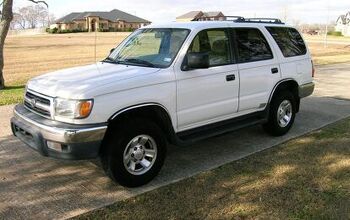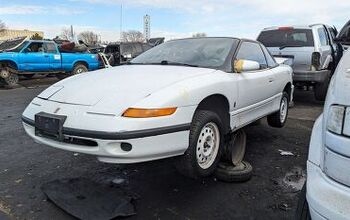SF Residents Disable Autonomous Vehicles With Traffic Cones

San Francisco has become a hub for companies wanting to test autonomous vehicles thanks to its progressive leadership and proximity to Silicon Valley. But local residents have slowly been losing patience with the vehicles themselves as they’ve grown in number. While malfunctioning AVs are never popular with other drivers, allowing them to operate without a human safety driver has resulted in rolling reports of vehicles clogging up traffic.
Self-driving test mules are programmed to exercise the maximum amount of caution whenever they’re uncertain of how to progress. This has resulted in traffic jams that are infuriating the locals. But it has also made them incredibly easy to defeat, with activist groups leveraging their circumspect behavior to disable them by placing a traffic cone on the hood.
The California Public Utilities Commission (CPUC) is expected to approve the expansion of both Cruise’s and Waymo’s autonomous vehicle passenger service deployments later this month. While the California Department of Motor Vehicles has enjoyed a contentious relationship with the brands, by previously disallowed autonomous vehicle deployment permits and being involved in a lawsuit after trying to make corporate crash data public, the DMV has also been under pressure to be kind to AV firms and allow them to operate test vehicles in select cities.
But reports have cited a growing sense of unease among local residents and select city agencies. Cabbies and Uber drivers have long despised the concept of robotaxis and they’re now starting to be joined by aspects of the local transit authority, emergency response personnel, and even San Francisco construction workers — who are now pressuring the city to scale back its allowance on autonomous test vehicles and provide guidelines that would keep them off the streets during periods of heavy traffic.
The reason has everything to do with their being inconvenienced. Over the past few years, videos have been released of self-driving cars interfering with city buses or holding up traffic when they encounter construction sites. We’ve likewise seen reports of vehicles getting into accidents, calling into question how roadworthy their systems actually are.
Police have even issued warrants to obtain video footage captured by autonomous vehicles operating in San Francisco and Arizona's Maricopa County. This is being done under the auspices of solving crimes and has locals feeling a little nervous about their privacy as their neighborhoods are turned into a corporate-funded surveillance state.
While being carted around by self-driving vehicles is a truly novel experience, the practice has opened places like San Francisco up to a host of new traffic issues that have inspired locals to petition the government to think twice about issuing permits. But progress has been slow and there are hundreds of vehicles already in operation — encouraging activists to take matters into their own hands.
A group called Safe Street Rebel has created the “ Week of Cone,” using social media to encourage citizens to disable Waymo and Cruise vehicles testing in San Francisco. The videos explain how AVs will effectively stop moving if someone places any relatively large object on their hood and recommends using traffic cones as the perfect option — as they’re readily available and unlikely to do any permanent damage to the cars.
Though the activists do make for some unlikely allies, as they’re not all that keen on automobiles in general. Safe Street Rebel describes itself as fighting for “car-free spaces, transit equity, and the end of car dominance.” It wants fewer vehicles on the road to make way for more bicycles, public parks, and lessened pollution. It’s also worried about “traffic violence” (car accidents) and is a major advocate for Vision Zero campaigns championed by city officials who want to promise a future where roadway injuries are made impossible.
Most proposals involve adding bike lanes, lowering speed limits, enhancing traffic enforcement efforts, expanding public transit options, and barring passenger vehicles from certain areas. There’s also a community outreach element designed to get the public on their side and a push to reduce vehicle ownership rates under the assumption that it would be better for the environment. They’re the traditional automotive enthusiast’s natural enemy. But they’ve elected to go after autonomous vehicles, creating some overlap with a subset of drivers who have absolutely had it with self-driving test mules.
The group has been sharing photos and clips of people disabling AVs on TikTok, Instagram, and Twitter over the last few days. Many include talk about how EVs (Waymo and Cruise both use all-electric fleets) pollute via contentious mining practices, level criticisms against self-driving vehicles that have held up SF public transportation or bike lanes, and note that the vehicles themselves lack accountability because there’s no human driver to receive a ticket. Some even call the vehicles “dog killers,” as there was an earlier incident where one AV fatally struck a small canine. There’s also been outrage over Waymo and Cruise allegedly working with the SFPD to hand over vehicle footage.
While the act of disabling AVs is unlikely to improve traffic flow. The frustration felt by locals having to circumvent a stalled test vehicle is valid and the response seems pretty measured. Safe Street Rebel isn’t encouraging people to damage vehicles. But disabling one with a traffic cone will force Waymo or Cruise to send out a technician and will draw an immense amount of public attention to how fallible modern AVs happen to be.
A spokesperson for Waymo told Road & Track that the company is not amused with the trend by stating “this understanding of how AVs operate [is not only] incorrect, but this is vandalism and encourages unsafe and disrespectful behavior on our roadways. We will notify law enforcement of any unwanted or unsafe interference of our vehicles on public roadways.”
We’re not sure what kind of offense someone would actually be charged with for interfering with an AV. But if you’re worried about that kind of thing, it may be easier to simply attend the California Public Utilities Commission meeting being held on July 13th to voice your concerns. Otherwise, it looks to be open season on San Francisco’s autonomous test fleets until they’re reissued human safety operators who could easily remove the cones.
[Image: @SafeStreetRebel/Twitter]
Become a TTAC insider. Get the latest news, features, TTAC takes, and everything else that gets to the truth about cars first by subscribing to our newsletter.

A staunch consumer advocate tracking industry trends and regulation. Before joining TTAC, Matt spent a decade working for marketing and research firms based in NYC. Clients included several of the world’s largest automakers, global tire brands, and aftermarket part suppliers. Dissatisfied with the corporate world and resentful of having to wear suits everyday, he pivoted to writing about cars. Since then, that man has become an ardent supporter of the right-to-repair movement, been interviewed on the auto industry by national radio broadcasts, driven more rental cars than anyone ever should, participated in amateur rallying events, and received the requisite minimum training as sanctioned by the SCCA. Handy with a wrench, Matt grew up surrounded by Detroit auto workers and managed to get a pizza delivery job before he was legally eligible. He later found himself driving box trucks through Manhattan, guaranteeing future sympathy for actual truckers. He continues to conduct research pertaining to the automotive sector as an independent contractor and has since moved back to his native Michigan, closer to where the cars are born. A contrarian, Matt claims to prefer understeer — stating that front and all-wheel drive vehicles cater best to his driving style.
More by Matt Posky
Latest Car Reviews
Read moreLatest Product Reviews
Read moreRecent Comments
- Jalop1991 In a manner similar to PHEV being the correct answer, I declare RPVs to be the correct answer here.We're doing it with certain aircraft; why not with cars on the ground, using hardware and tools like Telsa's "FSD" or GM's "SuperCruise" as the base?Take the local Uber driver out of the car, and put him in a professional centralized environment from where he drives me around. The system and the individual car can have awareness as well as gates, but he's responsible for the driving.Put the tech into my car, and let me buy it as needed. I need someone else to drive me home; hit the button and voila, I've hired a driver for the moment. I don't want to drive 11 hours to my vacation spot; hire the remote pilot for that. When I get there, I have my car and he's still at his normal location, piloting cars for other people.The system would allow for driver rest period, like what's required for truckers, so I might end up with multiple people driving me to the coast. I don't care. And they don't have to be physically with me, therefore they can be way cheaper.Charge taxi-type per-mile rates. For long drives, offer per-trip rates. Offer subscriptions, including miles/hours. Whatever.(And for grins, dress the remote pilots all as Johnnie.)Start this out with big rigs. Take the trucker away from the long haul driving, and let him be there for emergencies and the short haul parts of the trip.And in a manner similar to PHEVs being discredited, I fully expect to be razzed for this brilliant idea (not unlike how Alan Kay wasn't recognized until many many years later for his Dynabook vision).
- B-BodyBuick84 Not afraid of AV's as I highly doubt they will ever be %100 viable for our roads. Stop-and-go downtown city or rush hour highway traffic? I can see that, but otherwise there's simply too many variables. Bad weather conditions, faded road lines or markings, reflective surfaces with glare, etc. There's also the issue of cultural norms. About a decade ago there was actually an online test called 'The Morality Machine' one could do online where you were in control of an AV and choose what action to take when a crash was inevitable. I think something like 2.5 million people across the world participated? For example, do you hit and most likely kill the elderly couple strolling across the crosswalk or crash the vehicle into a cement barrier and almost certainly cause the death of the vehicle occupants? What if it's a parent and child? In N. America 98% of people choose to hit the elderly couple and save themselves while in Asia, the exact opposite happened where 98% choose to hit the parent and child. Why? Cultural differences. Asia puts a lot of emphasis on respecting their elderly while N. America has a culture of 'save/ protect the children'. Are these AV's going to respect that culture? Is a VW Jetta or Buick Envision AV going to have different programming depending on whether it's sold in Canada or Taiwan? how's that going to effect legislation and legal battles when a crash inevitibly does happen? These are the true barriers to mass AV adoption, and in the 10 years since that test came out, there has been zero answers or progress on this matter. So no, I'm not afraid of AV's simply because with the exception of a few specific situations, most avenues are going to prove to be a dead-end for automakers.
- Mike Bradley Autonomous cars were developed in Silicon Valley. For new products there, the standard business plan is to put a barely-functioning product on the market right away and wait for the early-adopter customers to find the flaws. That's exactly what's happened. Detroit's plan is pretty much the opposite, but Detroit isn't developing this product. That's why dealers, for instance, haven't been trained in the cars.
- Dartman https://apnews.com/article/artificial-intelligence-fighter-jets-air-force-6a1100c96a73ca9b7f41cbd6a2753fdaAutonomous/Ai is here now. The question is implementation and acceptance.
- FreedMike If Dodge were smart - and I don't think they are - they'd spend their money refreshing and reworking the Durango (which I think is entering model year 3,221), versus going down the same "stuff 'em full of motor and give 'em cool new paint options" path. That's the approach they used with the Charger and Challenger, and both those models are dead. The Durango is still a strong product in a strong market; why not keep it fresher?





































Comments
Join the conversation
As revolutionary statement, this action hardly ranks with the Weathermen, or even the Abbie Hoffman "Steal this Book" anarchy but I do laud their tactics and goals. I always think to myself when reading of the autonomous car research "why"? But, like the wholesale rejection of TV phones after the 1964 World's Fair, the modern population has a completely different mindset than I have now.
I saw that one of these whack-jobs MOs is to drive under the speed limit and hold up freeways!
Which would just entice me to fit some sort of deployable bumper or some sort of device where I could deploy, then slowly move up until the device connects with the bumper of the offending vehicle, then hit the gas! (Bonus points if I can PIT them safely off the road to the left, where they'd suddenly find themselves seeing traffic flying by in the opposite direction as they'd be sitting on the shoulder facing against traffic, with the only injury being to their self-righteous egos! Hopefully, aforementioned dilettantes would stay in their mommy's basements, where they belong!)
Then I think that I'd be tempted to do that EVERY TIME I come upon someone in the left lane not using their signals and staring at their phone, and yet following underposted numbers on a sign reading "SPEED LIMIT" with the fervor of followers of name-your-religion-of-choice on its highest holy day!
And then I think how much I'd love to do that in Northwest Ohio, where this zealotry is even now a high art form, and I realize I'd just land in trouble in a hurry!